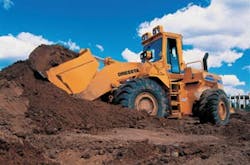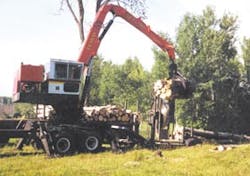Main system
The flow-controlled main hydraulic system matches pump capacity to engine power for responsive loader operation - providing the combination of speed and power needed to meet digging conditions. Flow-controlled hydraulics also conserve horsepower and improve fuel economy. Two Vickers VQ fixed-displacement, single-vane pumps - from Eaton Corp. - run off the engine's accessory drive through helical gears to supply the main hydraulic system. System relief is set for 3000 psi. The vane pumps produce high flow under high pressure - 128 gpm at 2100 rpm and 1000 psi - with much less noise than gear pumps, for example. In addition, the helical gears are quieter than often-used spur gears. Noise restrictions for construction equipment are a growing design consideration today. (These pumps have replaceable cartridge elements that simplify service when necessary.)
A 70-gal reservoir is mounted high on the rear bulkhead above the pumps. Gravity flow floods their suction sides and thus prevents cavitation. The cylindrical tank's exposed position also allows ambient cooling air to circulate over its surface. The closed reservoir has 30-psi pressure relief and vacuum relief located in its breather. The tank is fitted with a 10-µm full-flow filter as well as a suction screen.
The main valves have two spools, normally spring-centered in a body with end covers. A variable pressure signal applied to either end cover shifts the spools to stroke the working cylinders. A single joystick in the cab operates a small hydraulic valve that produces the pilot signals to the main valve. Pilot operation provides low-effort actuation that makes it easier to feather the loader's functions. The control console contains a hydraulic lock-out that the operator can set to prevent unintentional movement of the joystick.
An unloading valve is the key to the flow-controlled hydraulics. If high flow is needed for speed, the valve combines output flow from both pumps. When the job calls for high pressure - such as during breakout - the unloading valve diverts one pump's output flow directly to the reservoir. Using one pump at high pressure generates less heat in the hydraulic-system and leaves more power to be transmitted to the drive wheels.
Hydrostatic steering
One of the vane pumps supplies priority flow to the hydrostatic steering system, with any remaining flow directed to the main system. There is no mechanical link between the steering wheel and steering cylinders. (The steering column has tilt and telescoping capability.) When the steering wheel turns, it operates a small, low-effort Sauer-Danfoss pump that generates primary flow to the steering cylinders. A flow-amplifier valve increases the flow by a pre-determined multiplier and the combined flow strokes the cylinders.
Cooling system
A large 3-in-1 on-demand cooling assembly includes the engine radiator and coolers for transmission oil and hydraulic fluid. Temperature sensors in all three systems actuate a flow-control valve between the engine-driven gear pump and the gear motor that make up the hydrostatic fan drive. The valve has two settings: high speed for ambient temperature of 115° F and lower speed for 100° F temperature. The lower setting, which runs most of the time, consumes about half as much power as the higher. By tailoring fan speed to fluid temperatures, there is less noise, and fuel consumption is reduced. The operator can depress and hold a button to stop the fan for quick machine warm-up in cold weather.
Phone Dressta North American, Ltd. in Buffalo Grove, Ill., at 877 / DNA-2001 or visit www.dressta.com.
Probir Chatterjea, proDESIGNER, Inc., Sleepy Hollow, Ill., provided details about the design of the 555B wheel loader hydraulics.
CAN helps control log loader
Engineers at Lemco Hydraulics consulted with six customers in the logging business during the design phase of their XLT 280 knuckle-boom log loader. Ideas from these customers then were incorporated into the 30,000-lb lift-capacity machine.
What did the customers say they wanted? First, the creature comforts that every mobile-equipment user wants in the cab today. Then they had some more-challenging engineering requests: a single main-boom cylinder to improve visibility and valves mounted remotely from the cab to reduce noise and radiated heat. Of course they all wanted a user-friendly loader that operates very fast but smoothly. And most of all, they needed reliability.Lemco has always built for durability, and weight is a very important factor in the forestry industry. Weight conservation drives many aspects of Lemco's machine design process. This was their primary motivation to adopt high-pressure, load-sensing hydraulics. The high-pressure hydraulic system allows the use of smaller cylinders and pumps. Lemco uses high-strength steel for their own cylinders. This thinner and lighter material does not sacrifice any strength.
Parker Hannifin's Mobile Systems Div. and their distributor in Minneapolis, Van-Tech Corp., worked with the designers on the details of the hydraulic system. A 6-cylinder John Deere 6068T 185-hp, turbo-charged engine provides power for the XLT 280. (Cummins and Caterpillar engines are optional). A Parker P2-075 and two P2-145 variable-displacement, load-sensing pumps - driven through a splitter box on the back of the engine - supply flow on demand to the loader's hydraulic circuits. (To keep the system clean, Lemco installs a total of seven high-pressure and return-line filters.) The main control valve is a combination of Parker's K170LS and L90LS pressure-compensated, load-sensing valves that are manifolded together. Two more L90LS valve banks handle the lower frame functions and the ground saw.
The operator raises and lowers the main boom and opens and closes the grapple with the left-hand joystick. Its right counterpart rotates the grapple and raises and lowers the stick boom. A foot pedal controls platform swing.
The XLT 280 offers continuous swing using a pair of Parker F11-40 bent-axis hydraulic motors driving planetary-reduction gear boxes to balance the load on the slewing ring. The motors have integral Super-Shockless relief valves this provide a very smooth swing motion.
To update the operation of the XLT 280 loader, Lemco interfaces the operator with the hydraulic functions through Parker's IQAN electronic machine control system. This CAN-based system for mobile equipment improves the operator's control over the loader functions. The drivers in the IQAN system provide PWM or current commands to hydraulic valves fitted with proportional or digital solenoids. (The system interfaces with most common makes of valves). Using IQAN, Lemco was able to easily fine-tune the way the log loader works or even change it completely during the development stage.
With IQAN, operators in the field can adjust the basic function of the machine to suit their needs and abilities. For example, a novice operator may need to operate the log-loader functions at a slower rate because he or she is not as quick as an experienced operator. This adjustment can be accomplished by simple keypad inputs to the IQAN master display module (MDM) in the cab. As many as three operators can each store their personal settings in the system for easy retrieval at a later time.
IQAN also offers diagnostic capability. With a series of simple operations on the MDM's keypad, a non-functioning component can be isolated, saving hours of troubleshooting. Many of the IQAN components are self-diagnostic, and will alert the operator in case of failure. The result is very compact, operationally reliable, and service-friendly system that increases both productivity and the useful life of equipment.
Phone Lemco Hydraulics in Hill City, Minn., at 218 / 697-2694 or visit www.lemcohydraulics.com. Contact Parker Hannifin's Mobile Systems Div. in Lincolnshire, Ill., by phone at 847 / 821-9478 or visit www.parker.com.
Bruce Christensen with Lemco Hydraulics and Bob Horst with Parker Hannifin assisted with details for this report.




